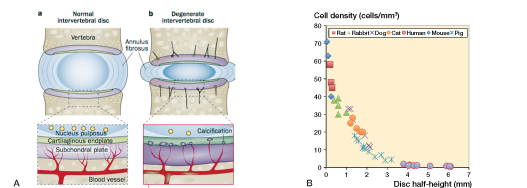Figure 4.

A. Schematic illustration showing nutrient pathways in a normal disc (a) and changes seen in disc degeneration (b). Most of the disc is supplied with nutrients by diffusion from capillaries arising in the vertebral body, which penetrate the subchondral plate and terminate at the junction with the cartilage endplate. Nutrients diffuse from these capillaries, through the cartilage endplate and disc matrix to the cells, which, in the center of a human disc, may be up to 8 mm from the nearest capillary. Nutrient supply is adversely affected in disc degeneration; disc degeneration is associated with atherosclerosis of the lumbar arteries and calcification of the cartilaginous endplate. Loss of nutrient supply leads to a fall in the number of active and viable cells that can be supported in the disc. (Reproduced from Huang et al. (2014) with permission). B. The inverse relationship between disc cell density across the nucleus pulposus and disc height. Cell density was measured in histological sections of discs taken from mice, rats, rabbits, cats, dogs, pigs, and humans. Here it has been plotted against disc half-height (adapted from Holm and Nachemson 1983).
